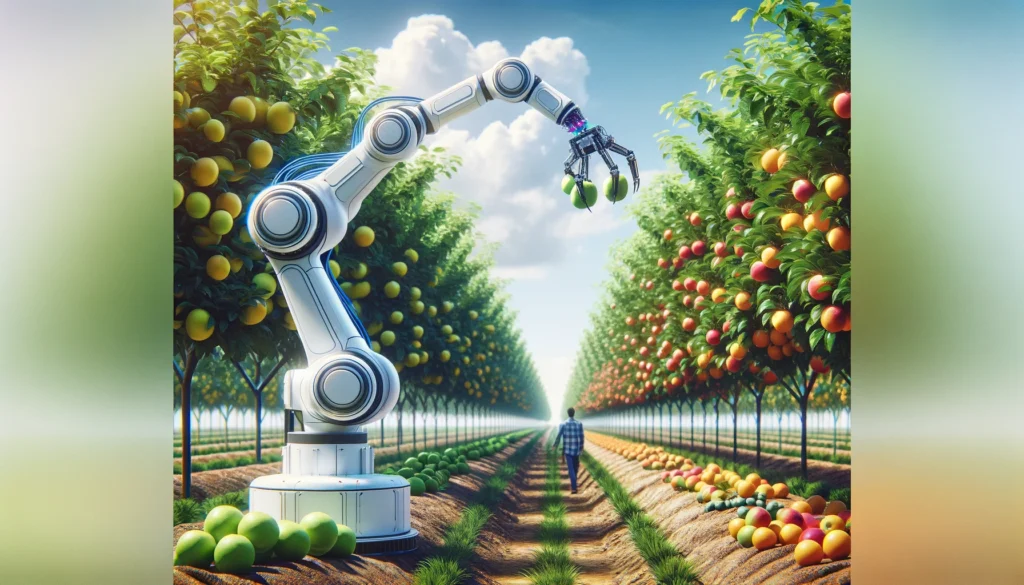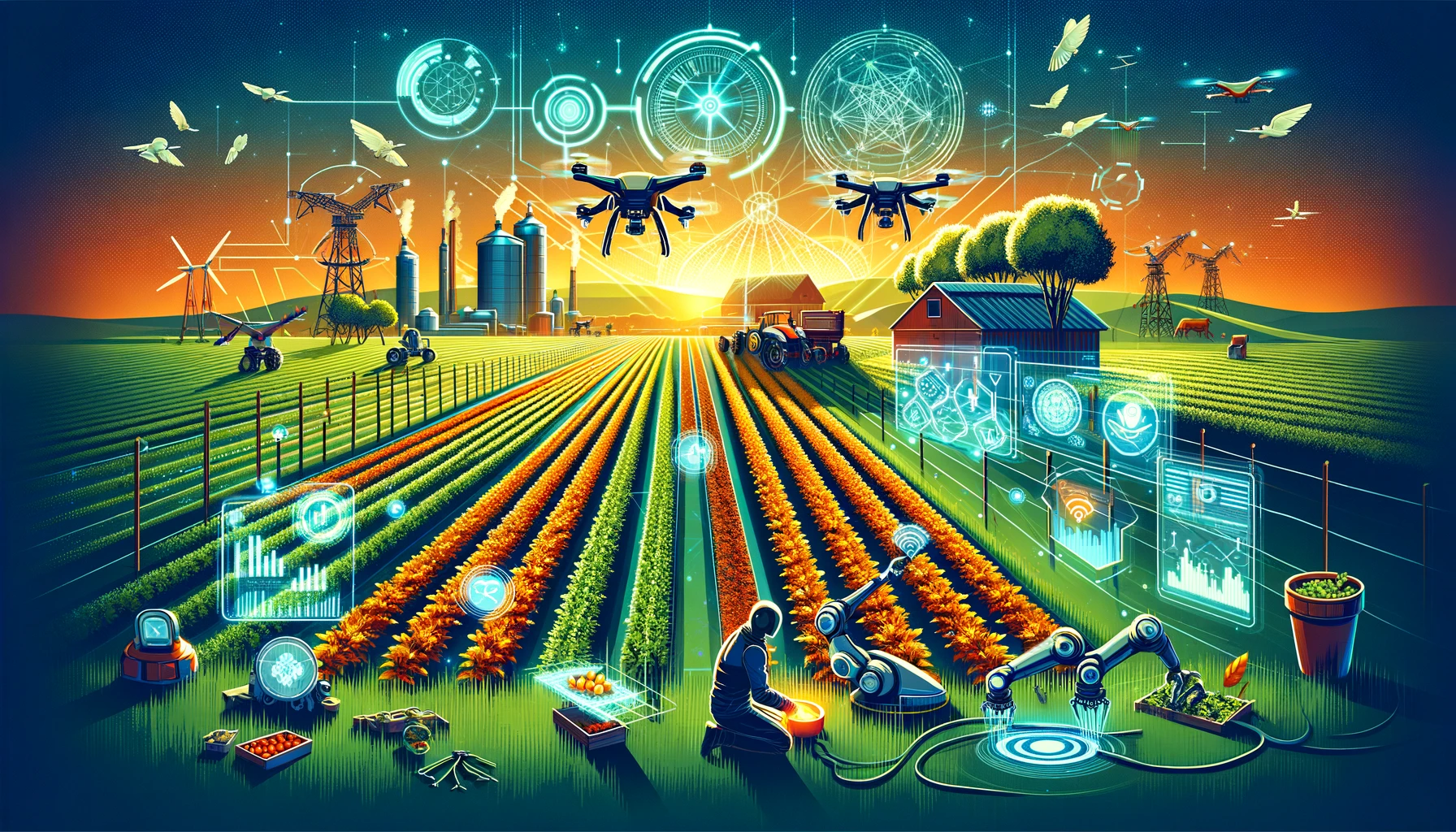Key Takeaways
| Aspect | Details |
|---|---|
| AI and Robotics | Enhancing efficiency and sustainability in farming practices. |
| Case Studies | Highlighting breakthroughs like Vegebot and FFRobotics. |
| Sustainable Practices | AI’s role in water and pest management. |
| Future Outlook | The potential and challenges of integrating AI in agriculture, with insights from Future Tech Trends. |
Introduction to AI and Robotics in Agriculture
Revolutionizing Agriculture: The Rise of AI and Robotics – The agricultural sector stands on the brink of a technological revolution, fueled by the advent of Artificial Intelligence (AI) and robotics. This transformation is driven by a critical need to meet the growing global food demand, address labor shortages, and ensure environmental sustainability. With innovations ranging from precision farming to autonomous harvesters, the integration of AI and robotics into agriculture promises to significantly enhance efficiency, reduce waste, and improve crop yields.
AI and Robotics in Agriculture: Case Studies: Success Stories in Agricultural Robotics
Precision Harvesting with Vegebot
AI and Robotics in Agriculture; Vegebot, a revolutionary robot developed by researchers, exemplifies the incredible potential of AI in agriculture. Designed to harvest lettuce, Vegebot uses computer vision to identify ripe produce, carefully picking it without causing damage. This innovation not only increases efficiency but also reduces the need for manual labor, showcasing the promising future of robotic farming. Such advancements are detailed further in the Technology and Fashion section, highlighting their broader implications for the industry.
Write Faster with AI Click Here
FFRobotics: Transforming Fruit Picking

FFRobotics is setting new standards in agricultural robotics with its fruit-picking robot. Capable of emulating human dexterity, this robot picks various fruits at a speed unmatched by human laborers. Its development, supported by insights from the Product Reviews section, underscores the role of robotics in overcoming the physical limitations of human workers and the challenges of seasonal labor shortages.
AI and Robotics in Agriculture: Enhancing Resource Management through AI
Water Management Innovations
AI-driven irrigation systems exemplify how technology can optimize resource management in agriculture. These systems analyze vast amounts of data from sensors and satellites to adjust watering schedules based on real-time soil moisture and weather conditions. As explored in Tech Reviews, such innovations not only conserve water but also ensure that crops receive precisely what they need for optimal growth.
Pest Management Solutions
The application of AI in pest management involves analyzing data to predict pest outbreaks and suggest targeted interventions. This proactive approach, discussed further in the Popular Questions section, helps farmers reduce reliance on chemical pesticides, leading to healthier crops and a lower environmental impact.
AI and Robotics in Agriculture: The Role of IoT and Drones in Precision Farming
The integration of the Internet of Things (IoT) and drones is revolutionizing precision farming, making agriculture more data-driven and efficient. IoT devices, such as soil sensors and climate conditions monitors, provide real-time information crucial for making informed decisions on crop management. Drones, on the other hand, offer aerial imagery that can be used for monitoring crop health, irrigation needs, and pest control strategies. This synergy between ground-based IoT devices and aerial drone data ensures that every square inch of a farm is analyzed and accounted for, leading to optimal crop production and resource management. Insights into these technologies can be found in the Artificial Intelligence Category, where the latest advancements in AI and their applications in agriculture are explored.
Write Faster with AI Click Here
AI and Robotics in Agriculture: Challenges and Future Directions
Overcoming the Digital Divide
While AI and robotics hold immense potential for transforming agriculture, their adoption faces significant hurdles, particularly in developing regions. The digital divide remains a substantial barrier, with many farmers lacking access to the necessary technologies, infrastructure, and training. Addressing this gap is crucial for ensuring that the benefits of agricultural technology are realized globally. Solutions and further discussion are available in the section on Understanding Machine Learning in Artificial Intelligence, which emphasizes the importance of making technology accessible and understandable to farmers everywhere.
The Rise of AI and Robotics 2024: The Next Frontier in AgriTech
As we look to the future, the possibilities for AI and robotics in agriculture seem limitless. From nanotechnology for soil health monitoring to genetic algorithms for crop breeding, the next generation of technologies could address today’s most pressing agricultural challenges. However, alongside these advancements, the sector must navigate issues such as data privacy, ethical considerations of automation, and ensuring that technological progress does not exacerbate existing inequalities. The evolving landscape of AgriTech and its potential is further explored in The Future of Artificial Intelligence: Trends and Predictions, providing a glimpse into what the future holds for farming.
AI and Robotics in Agriculture: Conclusion
The integration of AI and robotics into agriculture marks a pivotal moment in the history of farming. By enhancing efficiency, sustainability, and productivity, these technologies are not just transforming agricultural practices but are also helping to address some of the world’s most critical challenges, including food security and environmental sustainability. As we continue to advance, the focus must remain on ensuring that these benefits are accessible to all, paving the way for a future where technology and agriculture go hand in hand towards a more sustainable and food-secure world.
